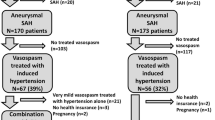Abstract
Neurotoxicity caused by intraarterial injection of low-dose low osmolar, iodinated contrast agents during radiologic studies is an extremely rare adverse event. Contrast medium induced disruption of the blood–brain barrier and a direct neurotoxic effect by contrast media have been proposed as a potential mechanism of neurotoxicity. This report describes an unusual case of transient neurotoxicity following diagnostic angiography mimicking clinically and radiologically subarachnoid hemorrhage. The patient recovered without any intervention after 4 days of conservative treatment.


Similar content being viewed by others
References
Davis K, Kennedy JW, Kemp HG et al (1979) Complications of coronary arteriography from the collaborative study of coronary artery surgery (CASS). Circulation 59:1105–1111
De Bono D (1993) Complications of diagnostic cardiac catheterization: results from 34, 041 patients in the United Kingdom confidential enquiry into cardiac catheterization complications. Br Heart J 70:297–300
Dangas G, Monsein LH, Laureno R et al (2001) Transient contrast encephalopathy after carotid artery stenting. J Endovasc Ther 8:111–113
Studdard WE, Davis DO, Young SW (1981) Cortical blindness after cerebral angiography. J Neurosurg 54:240–244
Utz R, Ekholm SE, Isaac L et al (1988) Local blood–brain barrier penetration following systemic contrast medium administration. Acta Radiol 29:237–242
Frontera JA, Pile-Spellman J, Mohr JP (2007) Contrast-induced neurotoxicity and selective cortical injury. Cerebrovasc Dis 24:148–151
Saigal G, Bhatia R, Bhatia S, Wakhloo A (2004) MR findings of cortical blindness following cerebral angiography: is this entity related to posterior reversible leukoencephalopathy? Am J Neuroradiol 25:252–256
Guimaraens L, Vivas E, Fonnegra A et al (2010) Transient encephalopathy from angiographic contrast: a rare case. Complication in neurointerventional procedures. Cardiovasc Intervent Radiol 33:383–388
Fang H, Kuo Y, Wu C (2009) Transient contrast encephalopathy after carotid artery stenting mimicking diffuse subarachnoid hemorrhage: a case report. Catheter Cardiovasc Interv 73:123–126
Ko DY (2000) Contrast agent neurotoxicity presenting as subarachnoid hemorrhage. Neurology 54(4):1014–1015
Velden J, Milz P, Winkler F et al (2003) Nonionic contrast neurotoxicity after coronary angiography mimicking subarachnoid hemorrhage. Eur Neurol 49(4):249–251
Landtblom AM, Boivie J, Fridriksson S et al (2006) Thunderclap headache mostly a benign condition. Investigation guidelines-subarachnoid hemorrhage should be excluded. Lakartidningen 103(37):2632–2634, 2637
Lam DH (2008) Subarachnoid haematoma after spinal anaesthesia mimicking transient radicular irritation: a case report and review. Anaesthesia 63(4):423–427
Author information
Authors and Affiliations
Corresponding author
Rights and permissions
About this article
Cite this article
Potsi, S., Chourmouzi, D., Moumtzouoglou, A. et al. Transient contrast encephalopathy after carotid angiography mimicking diffuse subarachnoid haemorrhage. Neurol Sci 33, 445–448 (2012). https://doi.org/10.1007/s10072-011-0765-3
Received:
Accepted:
Published:
Issue Date:
DOI: https://doi.org/10.1007/s10072-011-0765-3




